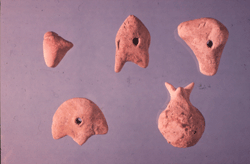Cuneiform
Cuneiform is the earliest form of writing. Cuneiforms were made by pressing a sharpened reed into a soft clay tablet to make wedge shaped letters. Cuneiform comes from the Latin word cuneus, meaning wedge. [1]
Pre-Cuneiform Clay Tokens
Small clay tokens of multiple shapes have been found in Near Eastern sites of 8000-3000 B.C. and constitute the earliest evidence for accounting, and constitute the current theory as to the origin of writing[2] . Clay 'envelopes' have been found alongside these tokens, and the current hypothesis is that initially such tokens were used for trade and to keep records. In the earliest instances, the tokens were merely sealed into the envelopes to secure the record. Somewhat later, in order that the contents of the sealed envelope could be read, the tokens were pressed into the wet clay of the envelope prior to sealing. Later on still, the tokens were left out of the envelope, which was then collapsed to form a clay tablet, with the tokens merely being pressed into the surface of the wet clay. This then became the record. The standard cuneiform tablet which evolved from this was then a small step. [3].
The development of Cuneiform
Pictograms were first used by the Sumerians around 3500 BC, a direct product of the fertile crescent. True wedge-shaped Cuneiform symbols were created around 3000 BC. Later the pictograms evolved into ideograms, and finally the modern Sumerian alphabet. [4]
References
- ↑ Spodek, Howard. The World's History. Upper Saddle River, NJ: Prentice Hall, 2006. 56.
- ↑ Schmandt-Besserat, Denise. 1992. Before Writing. Austin: University of Texas Press
- ↑ For a fuller explanation of this see: http://www.utexas.edu/cola/centers/lrc/numerals/dsb/dsb.html
- ↑ Spodek, Howard. The World's History. Upper Saddle River, NJ: Prentice Hall, 2006. 55-56.

